
|
Geological Survey Professional Paper 631
Analysis of a 24-Year Photographic Record of Nisqually Glacier, Mount Rainier National Park, Washington
|
QUALITATIVE INTERPRETATIONS
(continued)
DEBRIS COVER AND ITS DISTRIBUTION
Annual photographs are useful in a study of the
changing patterns of debris carried on a glacier's surface. Examples of
information about debris readily observable on the Nisqually Glacier
photographs are as follows.
The 1945 view in figure 4 shows that the extensive
load of debris carried on the east side of Nisqually Glacier between
altitudes of 5,700 and 7,000 feet (1,740 and 2,130 m) originates from
Nisqually Cleaver west of Gibraltar Rock, from the southwest slopes of
Gibraltar Rock and Cowlitz Cleaver, and from the down-glacier hillsides
bordering the east side of the glacier. In years of above-average
snowfall such as 1890 (fig. 2) and 1954 (fig. 22) this mantle of debris
was obscured by snow as far down the glacier as about an altitude of
5,800 feet (1,800 m).
The photographs in figures 20-25 also indicate that
the insulating effect of debris was responsible for development of the
debris-covered, high, moraine-like ridge of ice which was visible for
many years near the west edge of Nisqually Glacier downstream from
Wilson Glacier; and they show how this ridge later became obscured
during the new ice advance.
Changes in debris conditions are also illustrated in
figures 27-34, and described both in the picture captions and in the
section "Crevassing and General Character of the Glacier Surface."
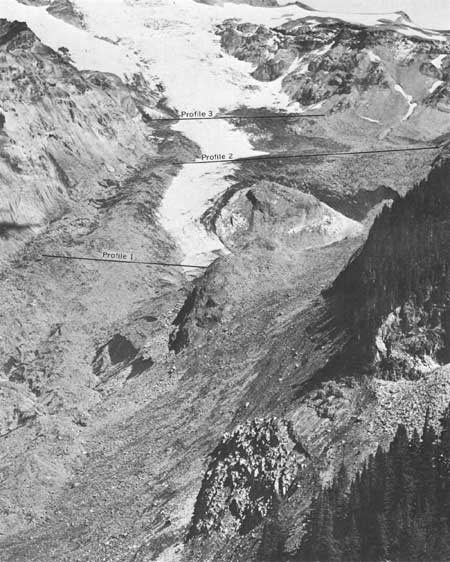
|
|
Figure 20.—Lower part of Nisqually Glacier as
seen from station 5 on August 31, 1942. Approximate locations of the surveyed cross
profiles are shown. Entire glacier is receding. Area down glacier from profile 1
(lower end of the white ice) is stagnant, as indicated by hummocky, debris-covered,
noncrevassed ice. Note the long morainelike ridge of debris-covered ice immediately
to left of the white ice. The nunatak is bare. Note debris load on right half of
the glacier from profile 3 downstream. (click on image for an
enlargement in a new window)
|
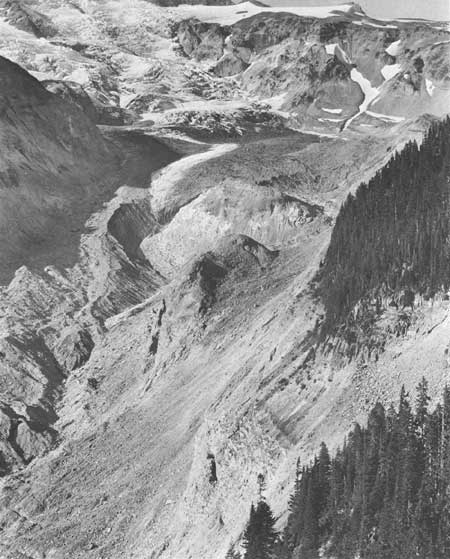
|
|
Figure 21.—Lower part of Nisqually Glacier as seen
from station 5 on August 22, 1951. Since 1942 the glacier has thickened by about 80
feet (24 m) at profile 3 and 40 feet (12 m) at profile 2, but it still is thinning at
profile 1. Note the lateral melting of ice ridge to left of the nunatak, as compared
with the 1942 view, and the exposed river bed. (click on image for an
enlargement in a new window)
|
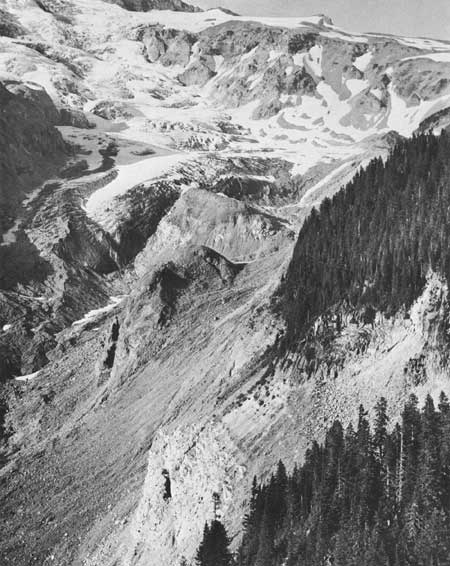
|
|
Figure 22.—Lower part of Nisqually Glacier as
seen from station 5 on September 1, 1954. This is the year of minimum ice mass at
profile 1, where, according to surveys, the glacier surface has dropped 13 feet (4 m)
since 1951; at profile 3 it has dropped 21 feet (6 m), but at profile 2 the glacier is
now 42 feet (13 m) thicker than in 1941. Note steep front of the vigorous advance of
fresh ice which is passing to left of the nunatak. Downstream from there the ice is
"dead" and melting away—slowly, however, owing to its insulation by a thick mantle
of debris. Surveys show that 1954 is the first year when a segment of the ice surface
near the west end of profile 1 began to rise. (click on image for an
enlargement in a new window)
|
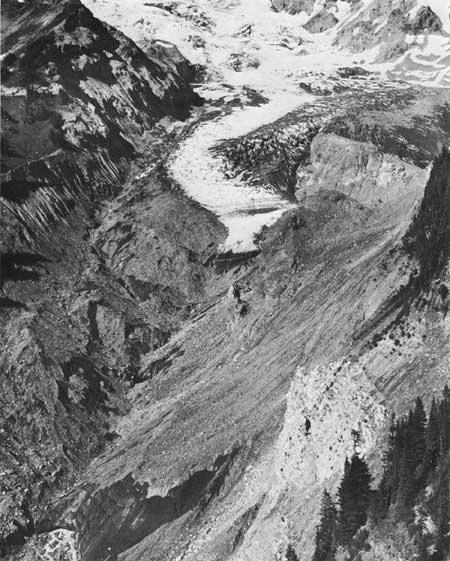
|
|
Figure 23.—Lower part of Nisqually Glacier as seen
from station 5 on September 11, 1959. With respect to its 1954 condition the glacier
now is 9 feet (3 m) thinner at profile 3, 12 feet (4 m) thicker at profile 2, and 70
feet (21 m) thicker at profile 1. The stagnant ice terminus now is visible at lower
left. Fresh, white ice has nearly obscured the debris-covered ice ridge opposite the
nunatak near the left (west) edge of the glacier. (click on image for
an enlargement in a new window)
|
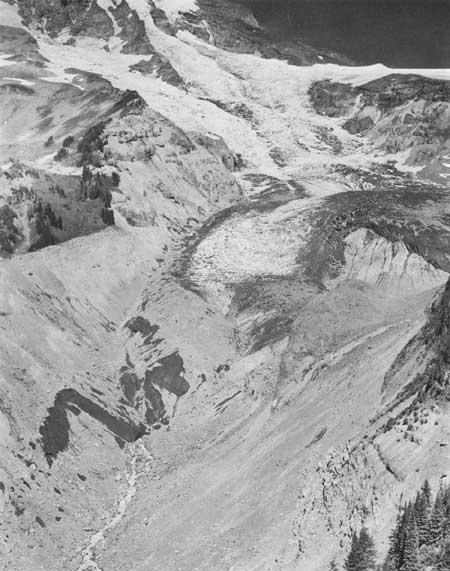
|
|
Figure 24.—Lower part of Nisqually Glacier as seen
from station 5 on September 8, 1962. Profile 3 is 7 feet (2 m) higher than in 1959, and
since then the glacier has thickened 22 feet (7 m) at profile 2 and 24 feet (7 m) at profile
1. The broad bulge of thickening is visible in midglacier in the vicinity at profile 2.
The nunataks has been topped by flowing ice. Dead ice downstream has receded considerably
since 1959, but now previously stagnant ice in midchannel is thickened and has been
incorporated in the advancing terminus. (click on image for an
enlargement in a new window)
|
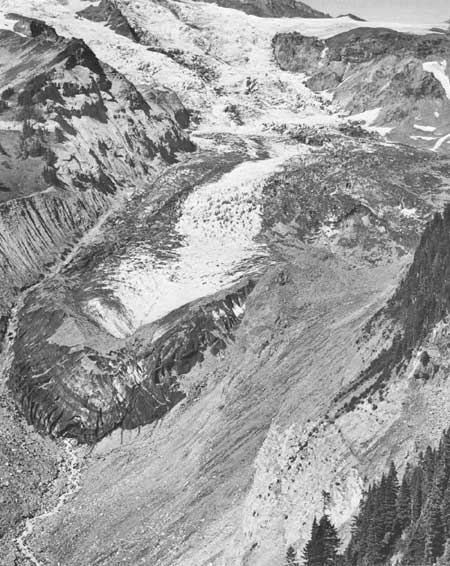
|
|
Figure 25.—Lower part of Nisqually Glacier as
seen from station 5 on August 30, 1965. With respect to its 1962 condition the
glacier has gained 3 feet (1 m) in thickness at profile 3 and lost 5 feet (2 m) at
profile 2; however, at profile 1 the thickness has increased 34 feet (10 m). The
preliminary result now available for the 1966 survey shows that 1965 was a peak year
at profile 1. The vigorous terminal reach and snout of the glacier have completely
covered or incorporated all vestiges of stagnant ice. The nunatak is almost entirely
engulfed. (click on image for an enlargement in a new window)
|
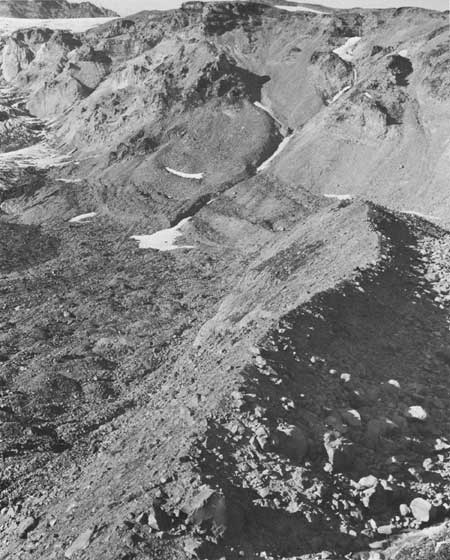
|
|
Figure 26.—Patterns of small recessional lateral
moraines on east bank at an altitude of about 6,400 feet (1,950 m) are evident in this
1940 view taken looking up glacier from station 12. The patterns suggest that at times
the recession progressed in a discontinuous manner, as in successive small steps
interrupted by slight advances. Photograph by F. F. Lawrence, Conservation Division,
U.S. Geological Survey, August 26, 1940. (click on image for an
enlargement in a new window)
|
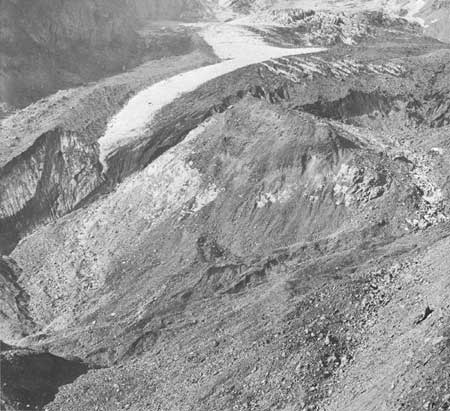
|
|
Figure 27.—Nisqually Glacier near the nunatak, as
seen from station 6 on August 27, 1952. Note long reach of
smooth-appearing, convex-upward slope of the white ice, terminating in
smooth black ice. Effect of advancing new ice now has nearly reached the
nunatak, as evidence in midglacier by the pronounced new (sharp-edged)
crevassing. Stream bed shows both to left and right of nunatak.
(click on image for an enlargement in a new window)
|
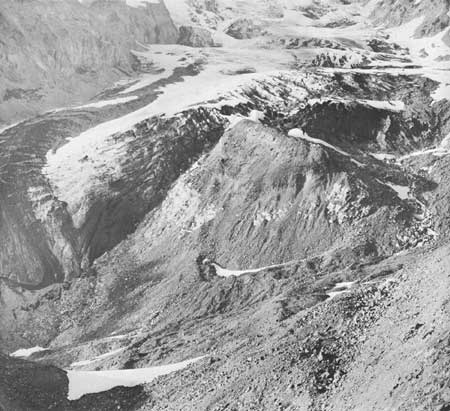
|
|
Figure 28.—Nisqually Glacier near the nunatak, as
seen from station 6 on September 1,1954. Practically all the main ice
flow from east half of glacier is being diverted to west side of the
nunatak. Note steep front of the fresh ice advance. (click on image
for an enlargement in a new window)
|
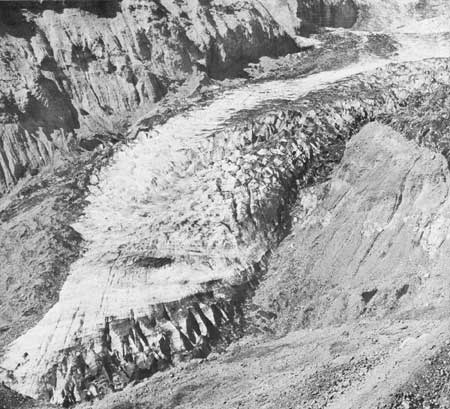
|
|
Figure 29.—Nisqually Glacier near the nunatak, as
seen from station 6 on September 5, 1958. Note growth and movement of
ice over peak of nunatak and along its east side which have occurred
since 1954. Crevassing in midglacier in the vicinity of the nunatak has
a very coarse pattern, and this photograph is a good portrayal of the
ablation of crevassed walls. This was a summer of abnormally high
ablation. The ice-cored, morainelike ridge noted at left in the 1942
view in series 5 (fig. 20) has nearly disappeared. (click on image
for an enlargement in a new window)
|
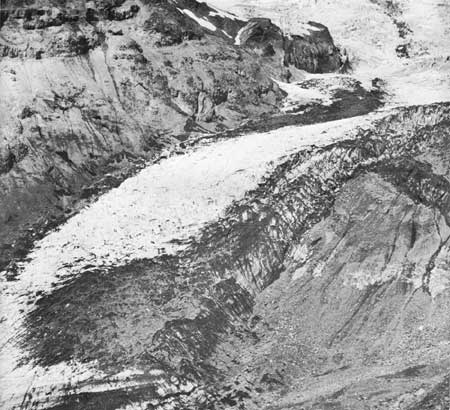
|
|
Figure 30.—Nisqually Glacier near the nunatak, as
seen from station 6 on September 6, 1961. Note finer pattern of the
crevassing in comparison with 1958, and the large patch of debris on ice
at lower left. Slope at profile 2 appears reduced. This is the fourth
consecutive year, beginning with 1958 (fig. 29), in which surveys show
that the elevation and slope of the glacier surface from profile 2 to
profile 1 have remained nearly constant. (click on image for an
enlargement in a new window)
|
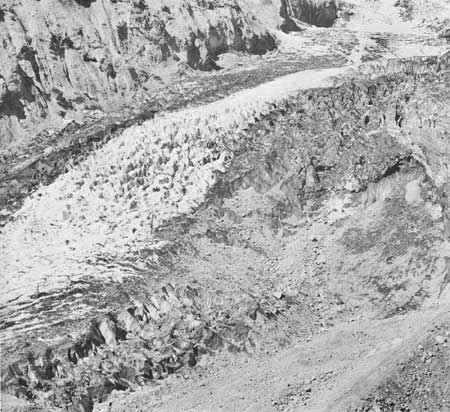
|
|
Figure 31.—Nisqually Glacier near the nunatak, as
seen from station 6 on August 30, 1965. Crevassing patterns this year
are generally coarser than in 1961. This wave of ice advance which is
engulfing much of the nunatak reached a peak at profile 2 in 1963 and at
profile 1 in 1965. Photographs show that a substantial part of the
east-half discharge is now continuing straight down glacier parallel to
the valley margins, in contrast to the 1952-54 conditions of nearly
complete diversion to the west. See also figures 5 and 25. The large
patch of debris visible in 1961 has gone, but debris still is surfacing
just to left of nunatak. Debris mantle again is continuous in reach
along west canyon wall where an ice ridge formerly existed. (click on
image for an enlargement in a new window)
|
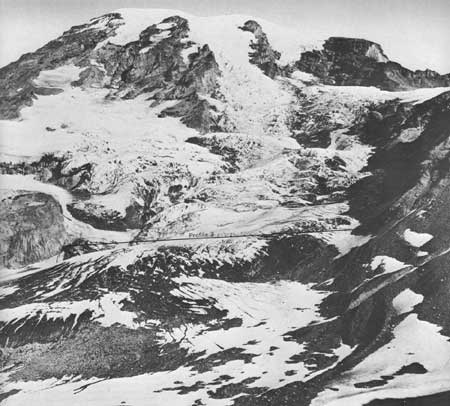
|
|
Figure 32.—Upper reaches of Nisqually and Wilson
Glaciers as seen from station 13 on August 28, 1949, taken several
hundred feet (say 150 m) up glacier from station 13. Location of profile
3 is shown. Along profile 3 the surface of the ice is 62 feet (19 m)
higher than in 1944 (Fig. 12); 19 feet (6 m) of this was added since
1948. Crevassing is becaming mare extensive. Bedrock outcrops at the
mouth of Wilson Glacier are nearly covered. Many of the bedrock outcrops
noted with X's in figure 12 (1944) are already covered by the expanding
glacier. (click on image for an enlargement in a new window)
|
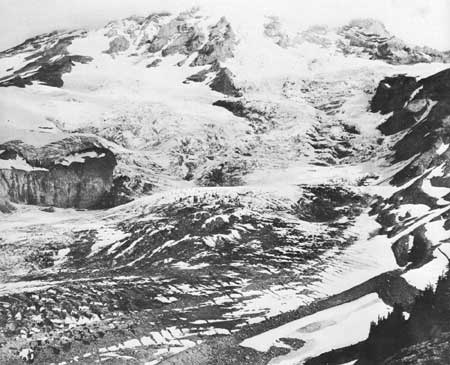
|
|
Figure 33.—Upper reaches of Nisqually and Wilson
Glaciers as seen from station 13 on August 30, 1957. Most of exposed
bedrock areas marked in figure 12 (1944) are now covered by Wilson
Glacier. Glacier surface at profile 3 is only 3 feet (1 m) higher than
in 1949, but near left edge of picture it probably is about 60 feet (18
m) higher because at profile 2 the ice level rose 97 feet (30 m) from
1949 to 1957. The crevassing appears much coarser (rougher) now and
extends to the east edge of the glacier. Exposed face of the ice field
above the cliff is thicker. The falls at far left are nearly dry
(compare with fig. 12). Note the different layers (ages) of firn exposed
in the small area at lower right, which can be differentiated by various
shades of gray. (click on image for an enlargement in a new window)
|
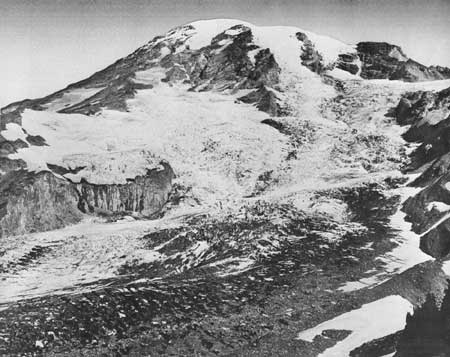
|
|
Figure 34.—Upper reaches of Nisqually and Wilson
Glaciers as seen from station 13 an August 30, 1965. The glacier from
profile 3 downstream to where it leaves this view has now reached a
steady-state condition, as determined by the annual surveys. In general
the crevassing appears similar to that of 1957. Firn can be seen in many
areas. Ice on cliff at left is much thicker than in 1957. (click on
image for an enlargement in a new window)
|
pp/631/sec4a.htm
Last Updated: 01-Mar-2006
|















